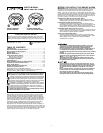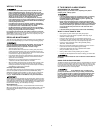
SPECIAL COMPLIANCE CONSIDERATIONS
This Smoke Alarm alone is not a suitable substitute for complete fire
detection systems in places housing many people—like apartment
buildings, condominiums, hotels, motels, dormitories, hospitals, long-
term health care facilities, nursing homes, day care facilities, or group
homes of any kind—even if they were once single-family homes. It is not
a suitable substitute for complete fire detection systems in warehouses,
industrial facilities, commercial buildings, and special-purpose non-resi-
dential buildings which require special fire detection and alarm systems.
Depending on the building codes in your area, this Smoke Alarm may be
used to provide additional protection in these facilities.
The following information applies to all four building types below:
In new construction, most building codes require the use of AC or
AC/DC powered Smoke Alarms only. In existing construction, AC,
AC/DC, or DC powered Smoke Alarms can be used as specified by
local building codes. Refer to NFPA 101 (Life Safety Code) or NFPA 72
(National Fire Alarm Code), local building codes, or consult your Fire
Department for detailed fire protection requirements in buildings not
defined as “households.”
1. Single-Family Residence:
Single family home, townhouse. It is recommended Smoke Alarms be
installed on every level of the home, in every bedroom, and in each bed-
room hallway.
2. Multi-Family or Mixed Occupant Residence:
Apartment building, condominium. This Smoke Alarm is suitable for use
in individual apartments or condos, provided a primary fire detection
system already exists to meet fire detection requirements in common
areas like lobbies, hallways, or porches. Using this Smoke Alarm in
common areas may not provide sufficient warning to all residents or
meet local fire protection ordinances/regulations.
3. Institutions:
Hospitals, day care facilities, long-term health care facilities. This Smoke
Alarm is suitable for use in individual patient sleeping/resident rooms,
provided a primary fire detection system already exists to meet fire
detection requirements in common areas like lobbies, hallways, or
porches. Using this Smoke Alarm in common areas may not provide
sufficient warning to all residents or meet local fire protection ordi-
nances/regulations.
4. Hotels and Motels:
Also boarding houses and dormitories. This Smoke Alarm is suitable for
use inside individual sleeping/resident rooms, provided a primary fire
detection system already exists to meet fire detection requirements in
common areas like lobbies, hallways, or porches. Using this Smoke
Alarm in common areas may not provide sufficient warning to all resi-
dents or meet local fire protection ordinances/regulations.
First Alert
®
is a registered trademark of the First Alert Trust.
6
Printed in Mexico M08-0020-002 J1 07/04
LIMITATIONS OF SMOKE ALARMS
Smoke Alarms have played a key role in reducing deaths resulting from
home fires worldwide. However, like any warning device, Smoke Alarms
can only work if they are properly located, installed, and maintained, and
if smoke reaches them. They are not foolproof.
Smoke alarms may not waken all individuals. Practice the escape
plan at least twice a year, making sure that everyone is involved – from
kids to grandparents. Allow children to master fire escape planning and
practice before holding a fire drill at night when they are sleeping. If
children or others do not readily waken to the sound of the Smoke
Alarm, or if there are infants or family members with mobility limitations,
make sure that someone is assigned to assist them in fire drill and in the
event of an emergency. It is recommended that you hold a fire drill while
family members are sleeping in order to determine their response to the
sound of the Smoke Alarm while sleeping and to determine whether
they may need assistance in the event of an emergency.
Smoke Alarms cannot work without power. Battery operated units
cannot work if the batteries are missing, disconnected or dead, if the
wrong type of batteries are used, or if the batteries are not installed cor-
rectly. AC units cannot work if the AC power is cut off for any reason
(open fuse or circuit breaker, failure along a power line or at a power sta-
tion, electrical fire that burns the electrical wires, etc.). If you are con-
cerned about the limitations of battery or AC power, install both types of
units.
Smoke Alarms cannot detect fires if the smoke does not reach
them. Smoke from fires in chimneys or walls, on roofs, or on the other
side of closed doors may not reach the sensing chamber and set off the
alarm. That is why one unit should be installed inside each bedroom or
sleeping area—especially if bedroom or sleeping area doors are closed
at night—and in the hallway between them.
Smoke Alarms may not detect fire on another floor or area of the
home. For example, a stand-alone unit on the second floor may not
detect smoke from a basement fire until the fire spreads. This may not
give you enough time to escape safely. That is why recommended mini-
mum protection is at least one unit in every sleeping area, and every
bedroom on every level of your home. Even with a unit on every floor,
stand-alone units may not provide as much protection as interconnect-
ed units, especially if the fire starts in a remote area. Some safety
experts recommend installing interconnected AC powered units with
battery back-up (see “About Smoke Alarms”) or professional fire detec-
tion systems, so if one unit senses smoke, all units alarm.
Interconnected units may provide earlier warning than stand-alone units
since all units alarm when one detects smoke.
Smoke Alarms may not be heard. Though the alarm horn in this unit
meets or exceeds current standards, it may not be heard if: 1) the unit is
located outside a closed or partially closed door, 2) residents recently
consumed alcohol or drugs, 3) the alarm is drowned out by noise from
stereo, TV, traffic, air conditioner or other appliances, 4) residents are
hearing impaired or sound sleepers. Special purpose units, like those
with visual and audible alarms, should be installed for hearing impaired
residents.
Smoke Alarms may not have time to alarm before the fire itself
causes damage, injury, or death, since smoke from some fires may
not reach the unit immediately. Examples of this include persons
smoking in bed, children playing with matches, or fires caused by
violent explosions resulting from escaping gas.
Smoke Alarms are not foolproof.
Like any electronic device, Smoke
Alarms are made of components that can wear out or fail at any time.
You must test the unit weekly to ensure your continued protection.
Smoke Alarms cannot prevent or extinguish fires. They are not a substi-
tute for property or life insurance.
Smoke Alarms have a limited life. The unit should be replaced imme-
diately if it is not operating properly. You should always replace a Smoke
Alarm after 10 years from date of purchase. Write the purchase date on
the space provided on back of unit.








